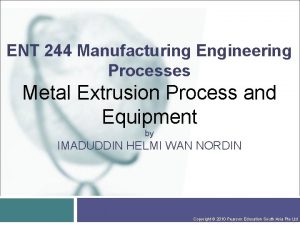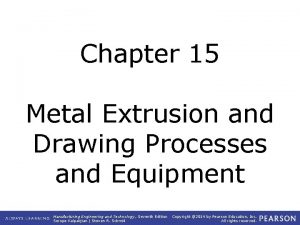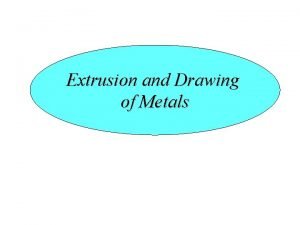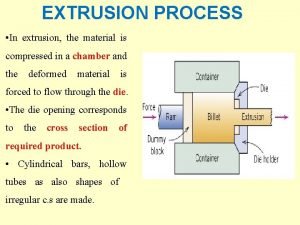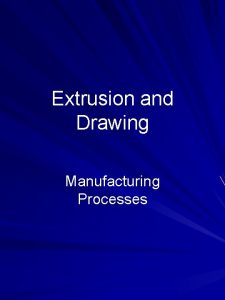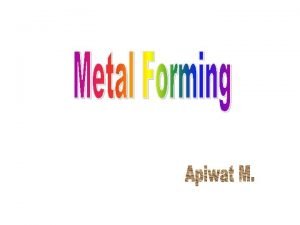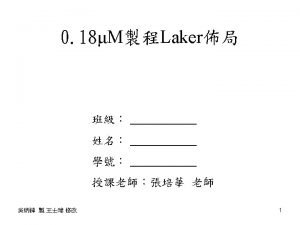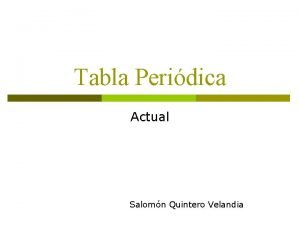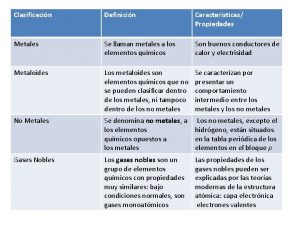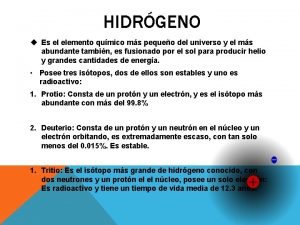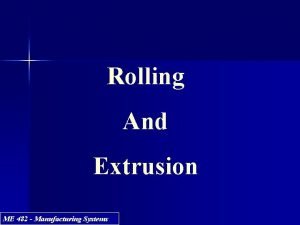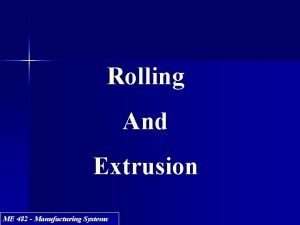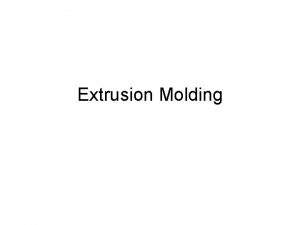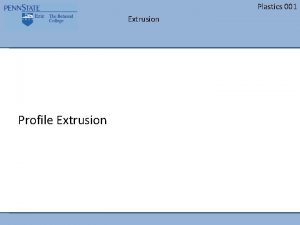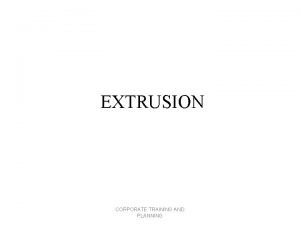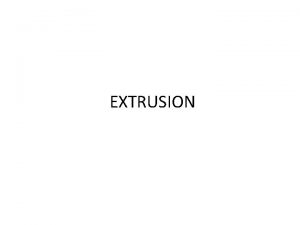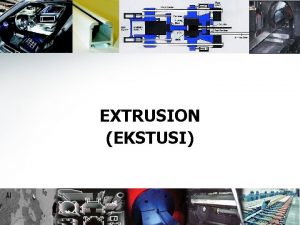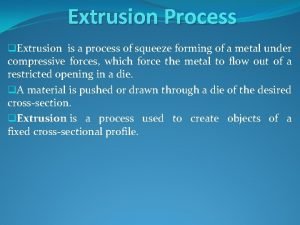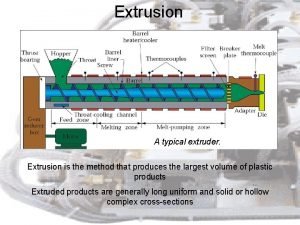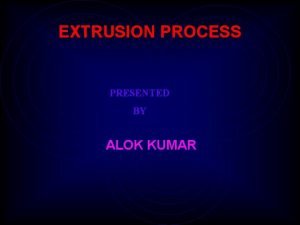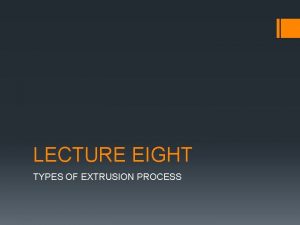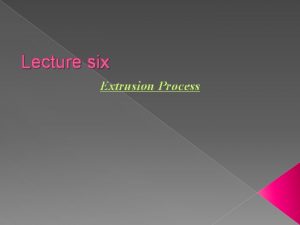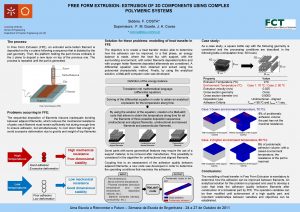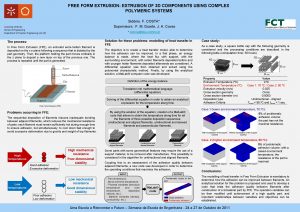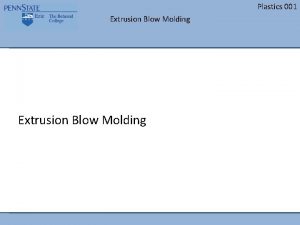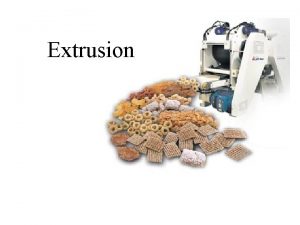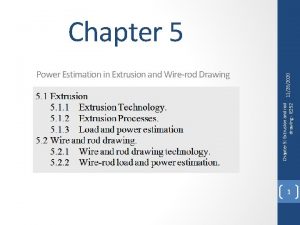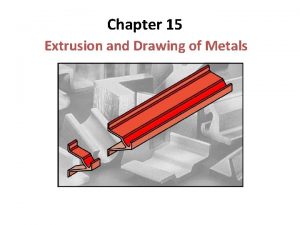Chapter 15 Metal Extrusion and Drawing Processes and






















- Slides: 22

Chapter 15 Metal Extrusion and Drawing Processes and Equipment Manufacturing Engineering and Technology , Seventh Edition Serope Kalpakjian | Steven R. Schmid Copyright © 2014 by Pearson Education, Inc. All rights reserved.

EXTRUSION a cylindrical billet is forced through a die DRAWING the cross section of a solid rod , wire or tube is reduced or changed in shape by pulling it through a die Manufacturing Engineering and Technology , Seventh Edition Serope Kalpakjian | Steven R. Schmid Copyright © 2014 by Pearson Education, Inc. All rights reserved.

FIGURE 15. 1 Schematic illustration of the direct-extrusion process. Manufacturing Engineering and Technology , Seventh Edition Serope Kalpakjian | Steven R. Schmid Copyright © 2014 by Pearson Education, Inc. All rights reserved.

FIGURE 15. 2 Extrusions and examples of products made by sectioning off extrusions. Source: (d) Courtesy of Plymouth Extruded Shapes. (For extruding plastics, see Section 19. 2. ) Manufacturing Engineering and Technology , Seventh Edition Serope Kalpakjian | Steven R. Schmid Copyright © 2014 by Pearson Education, Inc. All rights reserved.

FIGURE 15. 3 Types of extrusion: (a) indirect; (b) hydrostatic; and (c) lateral. Manufacturing Engineering and Technology , Seventh Edition Serope Kalpakjian | Steven R. Schmid Copyright © 2014 by Pearson Education, Inc. All rights reserved.

PROCESS VARIABLES reduction in cross sectional area die angle extrusion speed billet temperature lubrication Manufacturing Engineering and Technology , Seventh Edition Serope Kalpakjian | Steven R. Schmid Copyright © 2014 by Pearson Education, Inc. All rights reserved.

FIGURE 15. 4 Process variables in direct extrusion; the die angle, reduction in cross-section, extrusion speed, billet temperature, and lubrication all affect the extrusion pressure. Manufacturing Engineering and Technology , Seventh Edition Serope Kalpakjian | Steven R. Schmid Copyright © 2014 by Pearson Education, Inc. All rights reserved.

TABLE 15. 1 Typical Extrusion Temperature Ranges for Various Metals and Alloys. (See also TABLE 14. 3. ) Manufacturing Engineering and Technology , Seventh Edition Serope Kalpakjian | Steven R. Schmid Copyright © 2014 by Pearson Education, Inc. All rights reserved.

FIGURE 15. 7 Typical extrusion die shapes: (a) die for nonferrous metals; (b) die for ferrous metals; and (c) die for a T-shaped extrusion made of hot-work die steel and used with molten glass as a lubricant. Source: (c) Courtesy of LTV Steel Company. Manufacturing Engineering and Technology , Seventh Edition Serope Kalpakjian | Steven R. Schmid Copyright © 2014 by Pearson Education, Inc. All rights reserved.

FIGURE 15. 8 Extrusion of a seamless tube (a) using an internal mandrel that moves independently of the ram: an alternative arrangement has the mandrel integral with the ram and (b) using a spider die (see Fig. 15. 9) to produce seamless tubing. Manufacturing Engineering and Technology , Seventh Edition Serope Kalpakjian | Steven R. Schmid Copyright © 2014 by Pearson Education, Inc. All rights reserved.

FIGURE 15. 11 a extrusion. Two examples of cold extrusion; the arrows indicate the direction of metal flow during Manufacturing Engineering and Technology , Seventh Edition Serope Kalpakjian | Steven R. Schmid Copyright © 2014 by Pearson Education, Inc. All rights reserved.

FIGURE 15. 11 b extrusion. Two examples of cold extrusion; the arrows indicate the direction of metal flow during Manufacturing Engineering and Technology , Seventh Edition Serope Kalpakjian | Steven R. Schmid Copyright © 2014 by Pearson Education, Inc. All rights reserved.

IMPACT EXTRUSION Manufacturing Engineering and Technology , Seventh Edition Serope Kalpakjian | Steven R. Schmid Copyright © 2014 by Pearson Education, Inc. All rights reserved.

FIGURE 15. 14 Schematic illustration of the impact-extrusion process; the extruded parts are stripped by using a stripper plate. Manufacturing Engineering and Technology , Seventh Edition Serope Kalpakjian | Steven R. Schmid Copyright © 2014 by Pearson Education, Inc. All rights reserved.

DESIGN CONSIDERATIONS 1. symmetry of cross section 2. Avoid hollow cross sections 3. Avoid a critical dimension in a cross-section 4. Avoid wide thin sections Manufacturing Engineering and Technology , Seventh Edition Serope Kalpakjian | Steven R. Schmid Copyright © 2014 by Pearson Education, Inc. All rights reserved.

FIGURE 15. 17 Examples of poor and good design practices for extrusion; note the importance of eliminating sharp corners and keeping section thicknesses uniform. Manufacturing Engineering and Technology , Seventh Edition Serope Kalpakjian | Steven R. Schmid Copyright © 2014 by Pearson Education, Inc. All rights reserved.

FIGURE 15. 19 General view of a 9 -MN (1000 -ton) hydraulic-extrusion press. Source: Courtesy of Jones & Laughlin Steel Corporation. Manufacturing Engineering and Technology , Seventh Edition Serope Kalpakjian | Steven R. Schmid Copyright © 2014 by Pearson Education, Inc. All rights reserved.

DRAWING the major processing variables are the same as extrusion: die angle, reduction in area, drawing speed and friction along the die-work piece interface extrusion: material is pushed through the die drawing: material is pulled through the die Manufacturing Engineering and Technology , Seventh Edition Serope Kalpakjian | Steven R. Schmid Copyright © 2014 by Pearson Education, Inc. All rights reserved.

FIGURE 15. 20 Process variables in wire drawing; the die angle, reduction in cross-sectional area per pass, speed of drawing, temperature, and lubrication condition all affect the drawing force, F. Manufacturing Engineering and Technology , Seventh Edition Serope Kalpakjian | Steven R. Schmid Copyright © 2014 by Pearson Education, Inc. All rights reserved.

FIGURE 15. 21 Examples of tube-drawing operations, with and without an internal mandrel; note that a variety of diameters and wall thicknesses can be produced from the same initial tube stock (which has been made by other processes). Manufacturing Engineering and Technology , Seventh Edition Serope Kalpakjian | Steven R. Schmid Copyright © 2014 by Pearson Education, Inc. All rights reserved.

FIGURE 15. 24 Cold drawing of an extruded channel on a draw bench to reduce its cross-section; individual lengths of straight rods or of cross-sections are drawn by this method. Manufacturing Engineering and Technology , Seventh Edition Serope Kalpakjian | Steven R. Schmid Copyright © 2014 by Pearson Education, Inc. All rights reserved.

FIGURE 15. 25 An illustration of multistage wire drawing typically used to produce copper wire for electrical wiring. Shown is a five bull block configuration; wire drawing machines can incorporate 15 or more of these drums, depending on the material and wire size. Source: After H. Auerswald. Manufacturing Engineering and Technology , Seventh Edition Serope Kalpakjian | Steven R. Schmid Copyright © 2014 by Pearson Education, Inc. All rights reserved.
 The extrusion process
The extrusion process Extrusion and drawing
Extrusion and drawing Extrusion and drawing
Extrusion and drawing Side extrusion process
Side extrusion process Extrusion and drawing
Extrusion and drawing Concurrent processes are processes that
Concurrent processes are processes that Wholesale sheet metal forming
Wholesale sheet metal forming Acidity trends periodic table
Acidity trends periodic table Melting point of diamond
Melting point of diamond Use of nonmetals
Use of nonmetals Periodic table pure substances
Periodic table pure substances Spraggins fitness
Spraggins fitness Metals vs nonmetals properties
Metals vs nonmetals properties Example of metal
Example of metal Venn diagram gas liquid solid
Venn diagram gas liquid solid Metal 1 metal 2
Metal 1 metal 2 When a metal reacts with a nonmetal the metal will
When a metal reacts with a nonmetal the metal will Grupo b tabla periódica
Grupo b tabla periódica Propiedades de los anfígenos
Propiedades de los anfígenos Hidrgeno
Hidrgeno What is the shape factor for non-circular extruded section?
What is the shape factor for non-circular extruded section? Rolling and extrusion
Rolling and extrusion How to designing and managing service processes
How to designing and managing service processes
